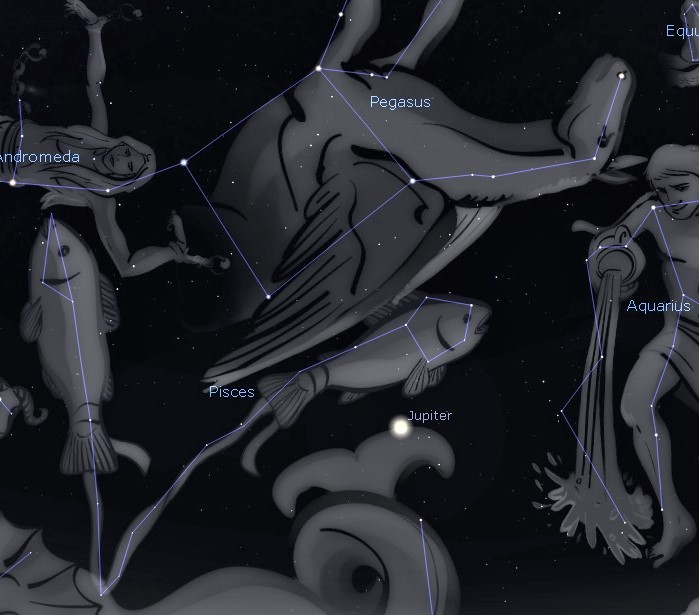This Week’s Sky at a Glance, 2022 October 15 – 22
~by Curt Nason
With the Square of Pegasus appearing higher in the east after twilight, look under it (or outside the first base line of the diamond) for a circle of fainter stars. This asterism is the Circlet of Pisces which forms the head of one of the two fish that make up this zodiac constellation. Below left of the circle, approximately where Jupiter is currently located, is the Vernal Equinox, the point where the Sun crosses the equator to mark the beginning of our spring season. At times it is still called the First Point of Aries, despite having moved well to the west of the zodiacal ram.
The fishes represent Aphrodite and her son Eros, who tied their ankles together with a cord before leaping into the sea and changing into fish to escape the fearsome monster Typhon. The star where the fishes’ tails meet is called Alrescha, which means “the cord.”
This Week in the Solar System
Saturday’s sunrise in Moncton is at 7:36 am and sunset will occur at 6:32 pm, giving 10 hours, 56 minutes of daylight (7:40 am and 6:38 pm in Saint John). Next Saturday the Sun will rise at 7:45 am and set at 6:20 pm, giving 10 hours, 35 minutes of daylight (7:49 am and 6:27 pm in Saint John).
The Moon is at third quarter on Monday, setting around 3:30 pm that day and rising again before midnight. Mercury remains bright at magnitude -1 all week, rising 85 minutes before sunrise this weekend but the gap closes to an hour by next weekend. Venus is at superior conjunction next weekend. Saturn is highest and best for observing at 9 pm, with Mars rising soon after and Jupiter reaching its peak at 11:30. On Monday at 7:53 pm, telescope and binocular users might see the moon Io disappear behind Jupiter, and later catch Europa and Io emerging from Jupiter’s shadow at 10:09 and 10:38 pm, respectively. Early risers next Friday and Saturday might notice a few meteors streaking from Orion’s upraised club as the Orionid shower peaks.
On Sunday evening at 8 pm, tune in to the Sunday Night Astronomy Show via the Facebook page or YouTube channel of Astronomy by the Bay.
Questions? Contact Curt Nason.

